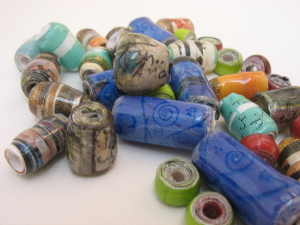Theme Essay by Karen J. Ohlson
In Cooking and Writing, It’s Okay to Savor Your Work
When I ask myself why I do things slowly, my stock answer is: I'm not choosing to be slow; it's the only way I know how to be. But if I'm honest, I know it's the only way I can feel satisfied.
Take, for example, making a salad. Why use bottled dressing when fresh vinaigrette tastes so much better? And it’s easy to make in the bottom of my big wooden salad bowl: a couple of tablespoons of olive oil, one of balsamic vinegar, a small clove of garlic smashed under the flat side of a knife to release its aromatic juices… and, of course, a scattering of finely-minced fresh basil, with a blob of Dijon mustard swirled in at the end.
Oops, just used up ten minutes. And that’s before I rinse the salad greens, sort through them to pick out the wilted bits, and devote a little time to scrubbing, peeling, and grating a carrot or two.
Picky and perfectionistic? Absolutely. But I’d feel anxious and rushed if I just dumped unsorted greens in a bowl and poured bottled dressing over them. And eating such a salad would be much less satisfying than eating—and savoring—the salad that takes half an hour to prepare.
Too bad there’s not a lot of patience in today’s fast-paced world for the “slow but satisfying” approach. Even the Slow Food Movement—a name that at first made me think, “Hallelujah! There are others like me!”—turns out to have more to do with opposition to fast-food values than with long preparation times. While the Slow Food Movement does venerate slowness, it’s slowness as a lifestyle choice, not slowness as a necessity.
And slowness does feel like a necessity to me—not just in cooking, but also in writing.
Letter-Quality Language
Years ago, in the days of dot matrix printers, people used the phrase “draft mode” to describe a high-speed, low-quality method of output. If you printed something in draft mode, it would use fewer dots to represent each letter than it did in “letter quality” mode, so the pages would print much faster. The edges of the letters were less crisp and the words were paler and blurrier, but that was okay when you weren’t printing a final version.
Many times, in my writing, I’ve wished that I could flip a switch in my brain and work in draft mode. But I’m a person who weighs word choices carefully. I feel my way along, casting about for the words that convey what I want to express. I need to get the rhythm right, the sentiment exact, to push me forward into the next true sentence. If I don’t find my way in this manner, I don’t get where I’m going. I don’t get anywhere.
“Turn off your internal editor,” you might tell me, to use a popular expression in writing workshops. Or maybe I should write “shitty first drafts,” as Anne Lamott advises, before editing them into much better versions.
I’ve been a fan of Anne Lamott since I read her first novel, Hard Laughter, which made me laugh so hard I almost choked on a sandwich. But the composing process she describes—which involves forcing oneself to keep typing without worrying about the writing being terrible and without backtracking to make changes—is my idea of hell. Forcing myself to ignore writing that’s “off” is like forcing myself not to pick out slimy bits of decaying greens as I make a salad.
Refrain from going back to fix the previous sentence when I just thought of a better way to say it? Why? If I don’t change it now, I might not remember the improvement when I come back to do that second draft. And if I suddenly realize I should have taken a different direction a paragraph ago, why not backtrack?
Once, in a writing workshop, the teacher asked us to bring in the first draft of a new story the following week. After we read mine, one classmate turned to me and said, with an undertone of accusation, “This isn’t a first draft.”
“Uh, actually, it is,” I said, “but it took me a really long time to write.”
Not Satisfied with a Quickie
And therein lies the dark side of being “good, but slow.” When friends in high school or college would talk about pulling an all-nighter to write a ten-page paper, my reaction was awe: “You can write that many pages in just one night?”
Sometimes they’d tell me what they wrote was bullshit, but I knew their ability to churn out a quick-and-dirty draft was an important skill.
“Draft mode.” They had it, and I didn’t. Which meant it didn’t seem practical for me to be, say, an English major in college (too many papers to write) or a reporter for the Associated Press (filing reports on the spot? No thanks).
But I couldn’t stay away from the siren call of words, which lured me to grad school in writing and then to work as a magazine editor and freelance writer. I couldn’t resist the seductive work of shaping words—not speedily, but carefully—into satisfying nourishment for hungry readers. Readers like Hantá, the narrator of the 1976 novel Too Loud a Solitude by Czech writer Bohumil Hrabal, who states on the opening page:
[W]hen I read, I don’t really read; I pop a beautiful sentence into my mouth and suck it like a fruit drop, or I sip it like a liqueur until the thought dissolves in me like alcohol, infusing brain and heart and coursing on through the veins to the root of each blood vessel.
Hantá is a lover of literature in Communist Prague, where art is considered bourgeois decadence and social usefulness rules the day. He works in a basement, drinking lots of beer to blunt his misery as he compresses books and other wastepaper into bales of pulp.
He’s supposed to work quickly to be of maximum use to society, but he can’t resist pausing to rescue as many rare books as he can fit in his briefcase. He also likes to give each bale of compressed pulp “my stamp, my signature”: a “precious relic” of a rare book in the bale’s center or a printed reproduction of a famous painting pressed into its side.
The mountain of old paper for Hantá to compress is constantly growing, and his boss yells at him for being too slow. He dreams of buying a press when he retires and taking it to his uncle’s garden, where, he says:
I’ll make only one bale a day, but what a bale, a bale to end all bales, a statue, an artifact… a bale I’ll never need to be ashamed of, a bale I’ll have time to think out, dream out, in advance.
When I came across that passage, I connected with it instantly. It expressed perfectly the frustration of being pushed to work too quickly, when all you want is just enough time to do it right—even if what you’re doing is compressing a bunch of wastepaper into a bale.
A Slow Work Movement? Anyone?
This is the true anguish of a too-fast life. It makes me yearn, as Hantá does, for a world in which slowness is appreciated. You'd think that current trends such as Slow Food, Slow Travel, and Slow Gardening would bring us closer to that goal. But the Slow Movement doesn't celebrate the slowness of careful work. It celebrates the slowness of leisure.
If you’re at leisure, with the time and money to support whatever you choose to pursue, you can embrace slowness with impunity.
You can adopt Slow Gardening, enjoying the sensory delights of nature as you harvest organic produce for your Slow Food meals. You can follow Slow Fashion, lovingly crafting your own clothes from locally sourced fabrics. You can even favor the travel method proposed in in "A Manifesto for Slow Travel," an article in the magazine Hidden Europe:
Donkeys, it seems, are an indispensable asset to the would-be slow traveller… why don't we all eschew trains and take donkeys?
Hey, why not? It’s your vacation time.
If you’re working, though, the notion of slowness gets dicier. For most of us, slow leisure is much more acceptable than slow work. When Hantá in Too Loud a Solitude reads slowly, letting each delicious sentence dissolve inside him, we approve; he’s living in the moment. When he takes the time to artfully compress each bale of paper, he’s a lazy bum—at least to his boss.
Time-intensive leisure? Great! Time-intensive work? Not so good—unless the time-intensive approach is seen as adding value. And this is where art comes into the picture: art and the immeasurable satisfaction it can bring, both to the creator and to those who encounter the finished work.
It’s My Love Story
In the opening lines of Too Loud a Solitude, Hantá tells us:
For thirty-five years now I’ve been in wastepaper, and it’s my love story. For thirty-five years I’ve been compacting wastepaper and books, smearing myself with letters until I’ve come to look like my encyclopedias—and a good three tons of them I’ve compacted over the years. I am a jug filled with water both magic and plain; I have only to lean over and a stream of beautiful thoughts flows out of me.
Was Hrabal’s writing process like this? Did his thoughts pour swiftly onto the page? If so, I doubt the process ended there.
Too Loud a Solitude is a mere 98 pages in length—a model of compression—and Hrabel’s most famous novel, Closely Watched Trains, is even shorter. Whether Hrabel poured and then compacted his thoughts (“a bale to end all bales”) or trickled them out slowly, his slim output speaks eloquently of a careful process. It is embedded with his stamp, his signature.
For Hrabal, I'm guessing, this was work worth savoring—as it is for me.
Publishing Information
- Too Loud a Solitude, by Bohumil Hrabal, translated by Michael Henry Heim (Harcourt Brace & Company, 1990). Titled Příliš hlučná samota in the original Czech, the novel was self-published by Hrabal in 1976.
- "A Manifesto for Slow Travel," Hidden Europe, March 25, 2009.
Art Information
- “Salad” © Jackie Chan; Creative Commons license
- “Vitamin Bomb” © Zsuzsanna Kilian; stock image
- “Paper Beads” © Tammy Gross; used by permission
 Karen J. Ohlson is the reviews editor of Talking Writing, home of the hands-on, “take the time to get it right” editing process—where she often finds herself thinking, “Hallelujah! There are others like me!”
Karen J. Ohlson is the reviews editor of Talking Writing, home of the hands-on, “take the time to get it right” editing process—where she often finds herself thinking, “Hallelujah! There are others like me!”
“Welcome to the YA section of the main library branch in Oakland, California—an area known as the “Teen Zone.” Everything about this room screams, “Reading is hip! There’s sex here, and violence, too!” —Not Your Mother’s YA Books



